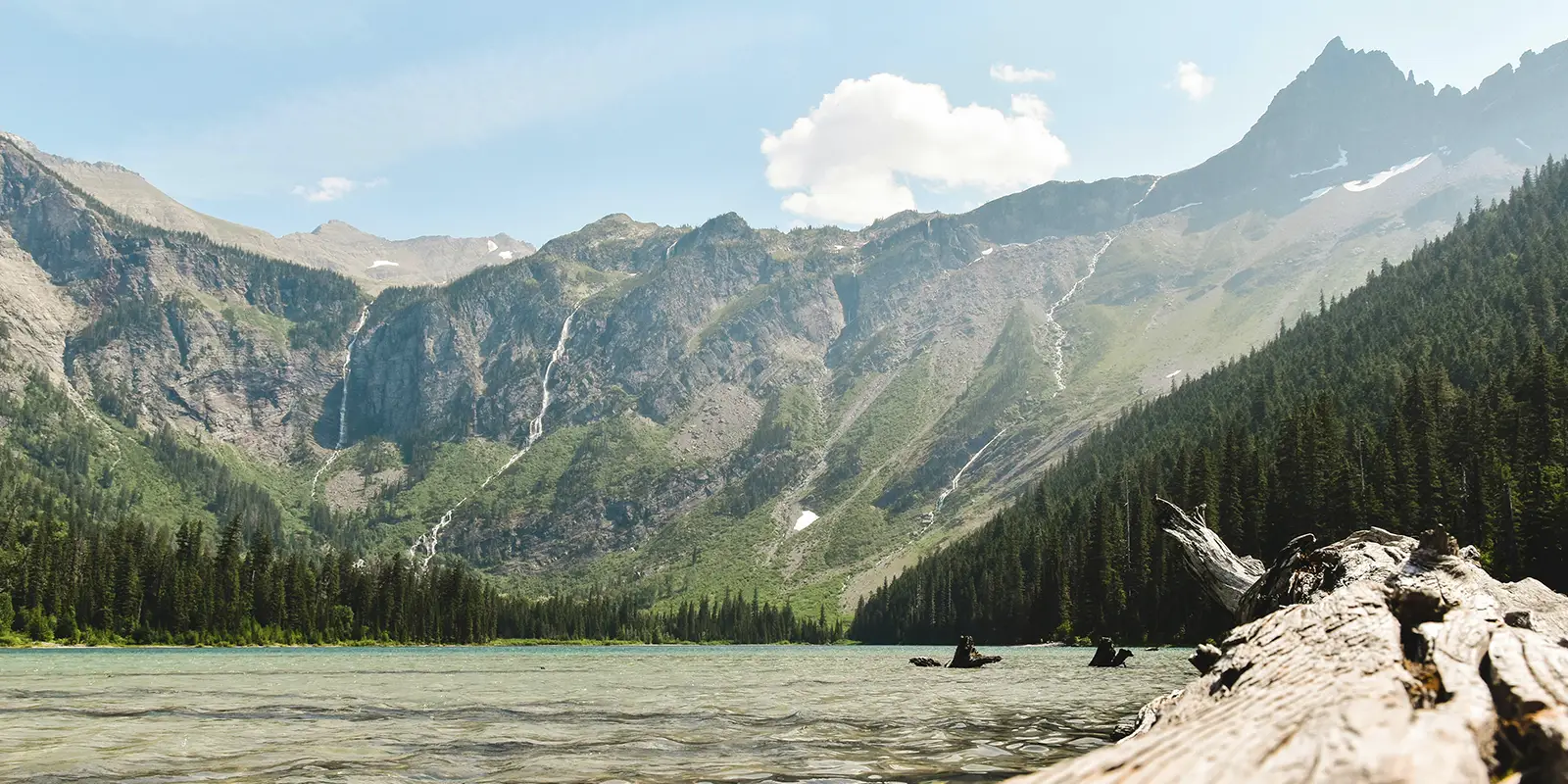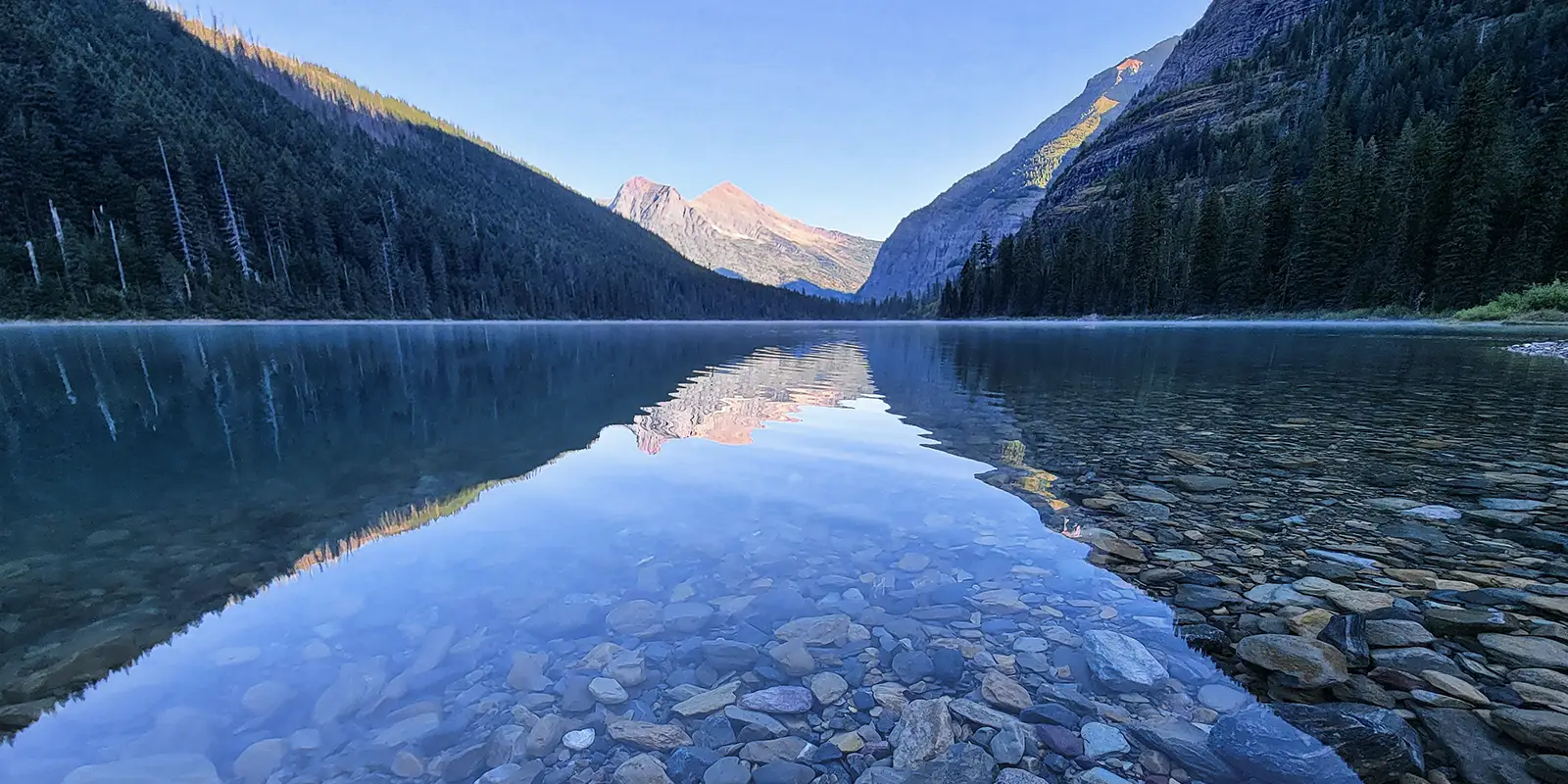In northwestern Montana, between Gunsight Mountain on the south, Bearhat Mountain on the east, and Heaven’s Peak on the north, lies a tiny body of water named Avalanche Lake. Avalanche Lake and natural wonders await adventurers in Glacier National Park.
A picturesque mountain landscape encircles the stunning alpine Avalanche Lake. Towering cliffs stand guard over it, while lush forests grow tall around it. Avalanche Lake is known for its pristine waters and majestic cascading waterfalls flowing off of Sperry Glacier that keep the lake full.
Can You Get to Avalanche Lake by Car?
Yes, you can drive most of the way to Avalanche Lake in Glacier National Park, Montana. To get there from West Glacier, Montana, on U.S. 2, you can:
- Turn northwest onto Going-to-the-Sun Road at the junction of US 2.
- Follow the road for 2 miles.
- Turn right at the junction with the Apgar Visitor Center.
- Continue for 14.4 miles.
- Turn right onto the spur road to the Avalanche Lake parking area.
- Follow the spur road for 350 ft. to the parking area on the left.
- It is a 1.6-mile hike to the northern tip of Avalanche Lake from the Avalanche trailhead.
Going-to-the-Sun Road closely follows Lake McDonald’s eastern shore. This entire road is 50-miles long and known for its scenic beauty through alpine forests, glacial lakes, and jagged cliffs, plus it crosses the Continental Divide at Logan Pass.
The parking area is shared with the Trail of the Cedars, Avalanche Campground, and the picnic area. It will accommodate about 100 vehicles. It is best to arrive early to find a parking spot. The parking lot usually fills up by 10 a.m. on good weather days. Visitors can find parking until 7:45 a.m.
Additional parking is available at the Avalanche Picnic Area or the Trail of the Cedars Parking Area. If visitors do not arrive early, they can take the shuttle bus from the Apgar Visitors Center in Apgar, Montana, on the southern tip of Lake McDonald. This is a better option during the summer season when parking is extremely limited.
Can You Get to Avalanche Lake Without Using Going-To-The-Sun Road?
Yes, but not with the aid of wheels. You have to hike it on the Trail of the Cedars. This trail is a wheelchair-accessible boardwalk loop that winds through a forest of larches, red cedars, and western hemlock trees along Avalanche Creek.

How Long of a Hike Is Avalanche Lake?
This popular hike meanders through nature’s magical way of forming land. On the way to Avalanche, views of Bearhat Mountain, the Hidden Creek drainage, and Mount Cannon pop up. A good plan includes starting your hike early to enjoy all the flora, views, and wildlife.
For a quieter experience, follow the trail along the lake’s western edge for 2.9 miles until you reach the lake’s head. Here, you will find several inlet streams fed by waterfalls flowing into the lake. To the north, you will be treated to a stunning view of Heavens Peak, which rises to 8,987 feet.
- Distance: 6.0 Miles, Round Trip
- Elevation: 3,405feet. at Trailhead
Elevation: 3,980 feet. - Elevation Gain: 575 feet.
- Difficulty: Easy to Moderate
- Basecamp: Lake McDonald
- Region: Glacier National Park, Montana
Does Avalanche Lake Have Waterfalls?
The three to five waterfalls that feed Avalanche Lake flow from above the lake at its southern end. The number of waterfalls depends on how much snowmelt is active. While hiking along the Avalanche Lake Trail, explorers find a clear view of these highly entertaining waterfalls pouring into the lake, especially from the head of the lake, about two miles from the trailhead.
A sweeping ridge of mountains encircles the southern tip of Avalanche Lake. The waterfalls flow intermittently around the mountain ridges. Snowfields above the waterfalls provide their waters. The Avalanche Lake Trail has three main parts:
- Trail of the Cedars: An easy boardwalk through a cedar forest that ends at the Avalanche Creek Gorge Bridge.
- Gorge and creek: A narrow gorge where glacial waters carve through it.
- Lake: A glacial melt lake surrounded by cliffs at the top of the creek.
Can You Swim in Avalanche Lake?
Yes, but the water is cold. Avalanche Lake’s water temperature seldom rises above 50° F. Park officials advise visitors to keep thirsty towels and dry clothes to hurry into after a dip and wear sturdy water shoes. Hypothermia occurs when a person’s body temperature drops below 95°F, and more commonly occurs in water temperatures below 70° F.
How deep is Avalanche Lake, Montana?
The exact depth of Avalanche Lake in is not well-documented, but it is relatively shallow compared to other alpine lakes in Glacier National Park. Precise measurements are not commonly available. Visitors often report that its clear waters make the lake’s bottom visible in some areas.
It is estimated that Avalanche Lake has a maximum depth of 63 feet. The lake is deepest at its upper northern end, with a depth of 58 feet near the shore, 63 feet at two-thirds distance from the lower southern end, and 54 feet halfway up from there. The lake’s lower southern end is only 4 feet deep.
Why Is Avalanche Lake Called Avalanche Lake?
Avalanche Lake takes its name from the frequent avalanches that occur in the surrounding mountains during the winter and spring seasons. These avalanches carve out paths down the steep cliffs, depositing snow and debris into the lake basin. The lake sits in a glacially carved cirque surrounded by towering peaks, making it prone to avalanches from the snowfields above. The dramatic landscape shaped by these natural forces inspired the lake’s name.
What Are Some Fun Facts About Avalanche Lake?
- A surveying party led by Judge John Richards and Major Reuben Sanford discovered the lake in 1833.
- William C. Redfield named the lake in 1833.
- Avalanches in 1869 and 1942 raised the lake’s level.
- The 1942 avalanche raised the lake’s level by 10 feet.
- The lake has a greenish color and at least three waterfalls coming down the mountains into the lake.
- Avalanches: The surrounding cliffs of Avalanche Lake witness frequent avalanches, especially in winter and early spring. These avalanches remodel the landscape seasonally and sometimes send debris into the lake.







